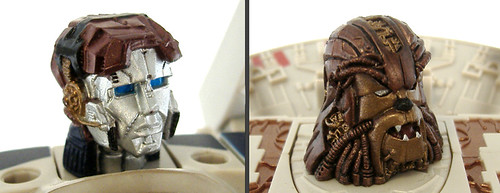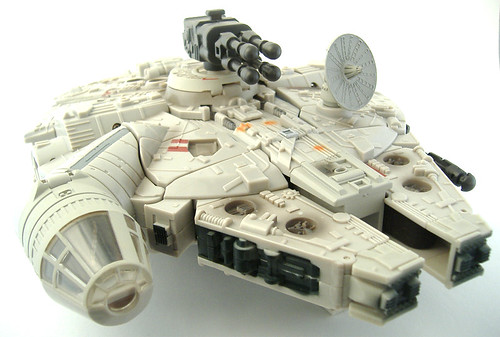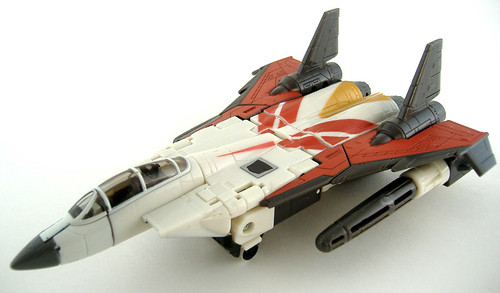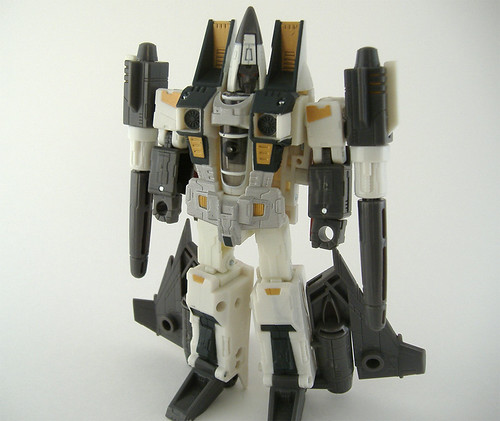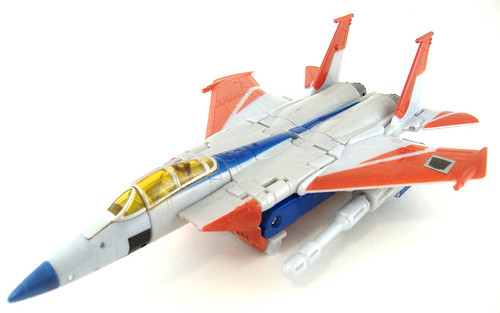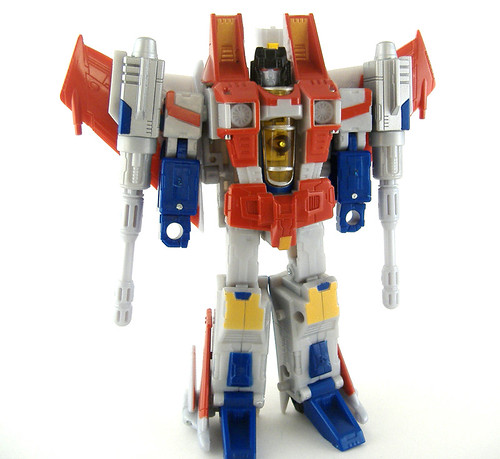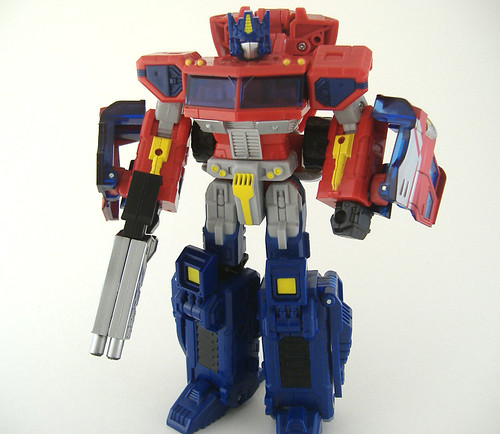I've been putting Gundam models together for close to 10 years. I don't claim to be an expert, but I've learned a lot through trial and error. When I started, I tried to find information out there to help me start, but most stuff assumed that the reader was already proficient in modeling, so I basically had to figure this out on my own. I wanted to share some of my tips for you beginners. IN NO WAY do I believe this is the ONLY way to do it, but I've found it to be almost hassle and frustration free. Of course, nothing works better than good old "experience." I don't paint my kits completely, mainly because I don't have the time (or talent), but I will paint the small detail parts if not molded in the correct color, or you are given a sticker to put on the part instead. These techniques aren't just for Gundam models, you can apply this to most Bandai, mecha, and Japanese kits.
Most Gundam models, especially the HGUC (High Grade Universal Century) and MG (Master Grade) kits, indeed most of the modern kits released by Bandai (which makes model kits for most mecha anime properties, it seems) look good right out of the box with most parts molded in the correct colors. I do plan, one day, (when I have more time and less children in the house) to fix up a painting rig and paint the kits, so I am in no way bashing those who show their models a bit more care and love than I do.
The FIRST thing to know is that you DON'T HAVE TO BUY YOUR SUPPLIES AT A HOBBY STORE! The stuff there is typically too expensive and too cheaply made. Most of the stuff you need you can find at the cosmetics department of your local Wal-Mart or mega-pharmacy. (For you men, don't fret about the thought of you hanging out in finger nail polish section. I do it all the time.)
Things you will need:
1) A Gundam model kit (obviously). The best place to buy these is HobbyLink Japan. Largest selection, lowest prices. The only drawback, these are shipped from Japan, so it will take a few weeks. The wait's worth it.
2) Something to cut the parts off the parts tree or sprue. Please avoid those specialty clippers you see down at the hobby shop. A pair of fingernail clippers works just fine. You don't have to get a fancy pair with a nail file and a little blade that digs gunk out from under your fingernails, just a plain old 99 cent pair will do. Plus, you can also use them to trim your fingernails. A Multi-tasker!
3) A GOOD hobby knife. I recommend a #2 knife made by X-Acto. The handle on the #1 knife is a bit small, so if you have smaller hands, you may like it. I spent $20 on a "Hobby Knife Set" at a hobby store, which was essentially a cheap knock-off of X-Acto's Basic Knife Set (which, as it turns out, sells for the same price at Wal-Mart.) Within three months, the magnet that held the extra blades in place came loose. Even worse, the blades began to rust and eventually became completely unusable. X-Acto's Basic Knife Set is pretty nice, but to be honest I've never used half the blades in my set. The blade that comes with the single X-Acto is perfect, and you can buy replacement blades in packs of 5 for about 99 cents. Please do NOT use a cheap imitation here. Cheaper knives have blades that dull very quickly. As any cook or chef can tell you, a dull knife is much more dangerous than a sharp one. You'll use more force to make a cut, and when it slips...GOODBYE FINGERTIP! (I've sliced my thumbs and fingers open enough times to know. Even a dull hobby knife cuts pretty deep.
4) Model Cement. I recommend the kind from Testor's that comes in a black triangular "tube" with a narrow plastic tip. (They used to make it with a metal tip that was MUCH better, but I guess it also made a good prison shank because they changed it to a tapered plastic tip.) There's a basic difference between model GLUE and model CEMENT. Model glue dries between two parts, and as the moisture from the glue dries, what is left behind is what forms the bond between the two parts. Model cement, on the other hand, actually melts a thin layer the polystyrene plastic and as this dries the plastic simply re-hardens. This basically "welds" the two halves together. I find this bond to be much stronger than the bond from model glue. Also, since the glue leave behind a trace layer between two halves, they will be a tiny bit wider than if you use cement. Since cement does not have this tiny layer, you get a better fit between parts.
5) Something to file and smooth the plastic parts. Sure, you can go down and buy that fancy modeling sandpaper most hobby shops sell. But I just use a simple finger nail file. I USED to use a two-sided fingernail file made by Fing'rs. It had one side that was half pink and half white that was two different "grits," one coarse and one fine. The other side was a gray "buffer." I can't find this one any more, so I found a brand that is essentially the same thing, only on three different finger nail files. A finger nail file is much easier to control than sandpaper, and you can fit it into tighter spots.
Optional Tools
6) Clothes pins (the kind with springs, not those old-timey ones.)
7) Q-tips
8) Cosmetic sponges (Ask your mom, sister, wife, or girlfriend.) I like the kind that is triangular or wedge-shaped.
9) Paint brush. Camel or other natural hair. Don't buy those el-cheapo brushes in Wal-Mart. Those are only good for...well, I don't really know what they're good for. Natural hair bristles are very thin, and make a hand-paint job look good. You can find a good brush for under 2 bucks. I have two brushes that I use, one that is a camel hair 1/4 inch (width) brush which cost $1.20, and a camel hair Detail brush (which has maybe 5 bristles, and tapers to a point). With these two brushes, you can paint anything from large areas to tiny little details like eyes.
10) A few sheets of Foam Rubber. (You can usually find this in a teacher supply store. Sometimes with letters and numbers molded into the sheets. These are only a couple of millimeters thick.)
11) Future Floor Wax
12) Cosmetics Brush (the kind used to apply blush, usually.)
There, that's basically all you'll need. Other than the model, that's what, maybe $10 bucks worth of supplies? Most of these you probably have laying around the house, anyway. Go spend $10 down at your local hobby store and see what that gets you.
Assembly
This is the basic assembly pattern, and you should use this on each final "piece" (foot, leg, arm, etc.), and not the entire kit as a whole.
1) Read the instructions! Even though most Gundam kits are in Japanese, they have nice pictures that are clear and easy to understand. Even though most Gundam kits (especially the 1/144 scale) follow a similar construction method, there may be a twist or turn that, if you miss, can be tough to fix once the parts are glued...err, cemented together. Also, don't go cutting all the parts off the sprue at once. Keep the parts on there until you need them. If you need to paint something, its easier to hold the sprue than it is to hold that tiny little part (Of course, if you want to paint, say, a whole leg, you're going to have to put the parts together before you paint.)
1a) Wash your parts trees in mild soapy water. Rinse, shake off the excess water and allow to air dry. (I'll explain why below).
2) Using your clippers or other cutting device, cut the part off the sprue (do NOT use your hobby knife for this, this will dull the blade quickly.) The trick here is not to cut the part too close. What I mean is, don't cut it right where the sprue ends and the part stops. You'll leave a divot, and this is not repairable without using putty. You want to avoid having to go get some. What you want to do is leave a little part of the sprue on the part, just a couple of millimeters, but enough so that you are not cutting the actual piece that is left. When finished, you should have the part you need, and it should have little "tabs" everywhere the part was attached to the sprue.
3) Using your SHARP hobby knife, trim those tabs off. The technique to use here is to place the edge of the knife's blade right at the point where that tab joins the part. Then, keeping the blade parallel to the part's surface (if it's flat), or nearly so (If it's rounded), apply gentle pressure and "shave" the tab off. You may have to do this a couple of time to get the part smooth. Practice this a little. Too little pressure and it will take you several attempts to get the tab cut off. Too much pressure and you may gouge the part's plastic. THIS IS NOT REPAIRABLE without extensive work.
3a) Put any polycaps in place if applicable. Polycaps are the small, rubbery plastic pieces (usually gray in color) that are used to form elbow, knee, and ankle joints. Some of the older 1/144 kits also used this for the kit's hands. Gundam kits are usually poseable, and a polystyrene on polystyrene joint would wear out very quickly. Polycaps are very durable, as well as soft, so the joints are very stable and can hold a position. DO NOT SKIP THIS STEP! I can't tell you how many times I've realized I forgot this step right after cementing the parts together. The resulting string of expletives can usually make a sailor blush. Check and Double-Check that you've done this before moving on!
4) Cement the pieces together. Here's where the specific Testor's cement I recommended comes in handy. It has a very slender applicator tip. What you have to do is cut the very end off the tip. Cut it very close to the end so that the hole the cement comes out of is as small as possible. Model cement is a clear liquid that is about as viscous as milk, so you have to be very careful with it. You don't want it running out all over the place. (You especially don't want it running out all over the plastic piece. Remember, this stuff MELTS plastic.) Usually, the parts of a Gundam model, if not a single piece, are molded from two separate "halves," either a left and right half or a front and back half. What you're going to do is run a VERY THIN layer of cement around an entire half (where this half will be touching the other half. The surface you are applying the cement to should be perpendicular to the outside surface you will actually see.) You may even want to very gently sand the two halves to remove any debris and level off and abrade the surface to give the cement something to hold on to.
NOTE: The current trend in some model kits is to have the joint actually contained within a "panel line" on the kit. (A panel line is a recessed line on the surface of a model that simulates a panel, armor plate, or two separate pieces of metal. Take a look here. All those black lines on the surface of the model are panel lines. If the gap between the two halves will be in a panel line, don't put cement here. You'll see why below.
Once you have applied cement to one half, CAREFULLY join the two halves together. Take care not to get any cement on your fingers. You won't notice until you put your finger tip on another piece of plastic and it sticks to your finger. It will etch your fingerprint into the model's surface. Once the halves are joined, apply gentle pressure to squeeze the two halves together, and count to 20 (one-mississippi, two-mississippi). If you did this properly, the cement (actually melted plastic) should be forced up out of the seam between the two halves. If you didn't apply too much, it will just form a little ridge and not run out everywhere. If you didn't apply enough, none will run out. This isn't bad, the two halves will still join together as long as there is SOME cement, it's just not ideal. Set the piece out of the way and let the cement cure. Overnight is good, 24 hours is better.
NOTE:If you have some clothespins and foam rubber sheets, here's where they come in handy. You can make a make-shift vice by cutting a few strips off your sheet of foam rubber, and gluing these (Elmer's works fine) to the inside of the gripping end of the clothes pin. You can use this device on smaller parts to maintain pressure on the two halves until the cement cures. The little notch in the clothes pin is perfect for some of the smaller pieces. Just be careful you don't get cement on anything, or you'll have a mess on your hands.
5) Once the pieces have cured, you have an actual PART. A leg, a forearm, shoulder armor, a head, etc. But you also have that ugly little ridge of cured plastic sticking up between what used to be the two halves (remember, you've welded the plastic together, now its truly one piece of plastic.) You've got to clean that up to make it presentable. No problem! You're simply going to use the same technique you used in shaving those tabs off the parts you have cut off the sprue. Place the blade parallel to the part's surface, and hold it about a 30 degree angle. Use the same motion you used to "shave" that tab off, only shave off the ridge of plastic that came up out of what used to be the seam between the two halves. When you get done, you should have the surface should be flush and fairly smooth. The plastic may be a little discolored, but you can always paint over it. It always looks better, IMO, than a big ugly seam-line.
6) Sand the parts. Use the coarse grit fingernail file, then the fine grit, and finally the buffer. If you do this over the former seam-line, the piece will look uniform and whole, and shiny to boot! Sanding also helps you clean up mold lines.
NOTE: Plastic models are sometimes called injection kits. This name comes from the process used to create the individual parts trees or sprues. Each sprue has an individual mold. A mold is created from two dies, a top and bottom half. These dies are pressed together to form the mold and molten polystyrene plastic is INJECTED into the mold. After the plastic hardens, the two dies are removed and what's left between them is the sprue. A tiny bit of lubricant is sprayed into the mold before the plastic is injected so that the finished product will release from the mold, this is why you should wash your kit before assembly. Unfortunately, the dies are not always aligned correctly (sometimes off by a nanometer), and this will leave a mold line. The dies may also not be completely pressed together, (they wear out over time) and a small amount of plastic will run between the dies, leaving behind a small imperfection called "flash." If you ever played with green army men, you've probably seen flash and mold lines before. The flash was usually a small circle on the back of the helmet, from the point where the plastic was injected into the mold used on the figure. Flash is VERY uncommon on more modern kits, at least those made by Bandai.
There you're mostly done, and could stop there, but your kit may not look quite right.
7) Painting. Paint any parts that are not molded in the correct color (you don't have to if you don't mind color inaccuracy.) I recommend Acrylic paints. These are water based and are easier to clean up than enamels. You just have to wash your brush in water. Enamel paints are oil based and require thinner to clean your brush. But don't IGNORE enamel paints! Enamels are usually thicker and are great for painting smaller details. I can't stand the way red polystyrene looks (too...uhh...plastic-y), so I always paint anything that's molded in red. Paint anything that you are given a sticker for (don't put the sticker on, though!) These are usually eyes things like eyes, scopes on weapons, cameras and sensors. Also, you should paint the inside of the models vernier (rocket) nozzles either black, red or yellow. (look to the pictures included with the instructions for guidance.)
7a) Once you've finished painting, you may want to seal the paint. Model paint is very delicate and can easily be scraped or scratched off. Here's where the Future Floor Wax comes in. Brush a very thin layer of Future over any part you have painted, and the paint job becomes nearly indestructible. Okay, not really, but it will be more durable than not sealing the paint. However, keep in mind that Future will leave your paint with a gloss or semi-gloss finish, so I wouldn't do this on anything you want to have a matte finish. There are paint sealers specifically made for plastic models, including matte finishers, but I never fool with them. Future is also acrylic, so cleaning up your brush is a snap.
8) Put your finished model kit on a shelf and admire it from time to time.
9) Your kit will get dusty from time to time (unless you keep your house spic and span.) Whip out that make-up brush and GENTLY use it to brush away the accumulated dust.



